Introduction
In the Archivio di Stato di Firenze, ASF,(1) the Inventory N.243 corresponds to sections of Gabelle, including the one of interest here, “Ufficio del bollo e marchio di Firenze”, which also contains documents on the Florentine playing card production in the last part of the 18th century and early 19th.
In this section, we find listed no fewer than 114 items. Now, I have essentially limited my attention to books, for which playing cards have been explicitly mentioned in the Inventory. Relevant items are No. 16, which has already been used in a previous research;(2) Nos. 74 to 85, which have been examined in a recent study.(3) The last item to examine is No. 19, which I had checked many years ago, when I found in it a few records of Cucu cards.(4) I have studied it again in the last weeks and am reporting the main results in this note.
It is likely that our subject is present in other books of the series, for instance in those containing official letters to or from the Ufficio del bollo, even if the activity of the office was probably directed more to stamped paper than to playing cards.
1. Filza No. 19
The folder in this case is again a big 24x32 cm one; it is particularly thick as well - 13 cm. It has a completely different structure in comparison with similar items, which mainly consisted in one or more registers bound together.
This Filza is neither a book, nor a register, nor any cash book. It has just been formed by assembling together the most various individual sheets of paper. Most of them have a rather standard dimension, similar to our A4 sheets, but interposed between them we find a lot of smaller leaflets, down to the dimension of a post card.
The contents are similarly various. Of course, the topic is always that of playing cards and their administration by Ufficio del Bollo. As title we read: “Recapiti per l’Uscita del Camarlingo riguardanti le Carte da Giuoco dal 1775 al 1787”.
Apparently, cards were then distributed by the Ufficio itself, which directly purchased them from the local cardmakers. Here, we do not find any information on the incomes of the Ufficio: all this documentation deals with expenses. We find here gathered together yearly summaries and single receipts, lists of payments of the salaries to the staff and small expenses for the office, to begin with stationery.
In front of such mixed material, it is a hard task to give a complete report of these documents. On the other hand, it may be too reductive to limit the examination to dig just a few yearly balances and the corresponding amounts of playing cards. The main object of this study is actually to provide information on playing cards production, but I will likewise deduce some ancillary information, whenever it appears suitable and interesting enough.
As it often happens with bureaucratic material, what at first sight appears to be a very chaotic group of documents can be acknowledged later on as a rationally organised set. This is indeed the case here, because the most various elements have been preserved in a methodical way – one has only to understand the method.
The result of this analysis is that we can see this whole Filza simply as several yearly folders collected one after another, without any marked separation between them. If they had distributed the contents in a dozen folders, one for each year, instead of a single one, the consultation could have been easier.
As soon as one is encouraged by finding that, after all, this huge quantity of loose sheets can be seen as an orderly set of documents, new problems arrive, because the collecting criterion mentioned is not at all satisfied correctly in every case.
2. The 1776 expenses
Let me first describe the documents of 1776, the second year of those involved in Filza 19, because they are more regularly collected and allow us to understand the underlying procedure better.
2.1 The complete annual balance for 1776
We first read a single page with the following Table:
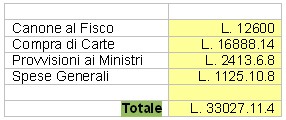
Clearly, the most essential information is the total yearly amount of all the expenses of the Ufficio, L.33027 s.11 d.4. This amount appears here to derive from four different contributions, as follows.
a) Canone al Fisco, the fee to be paid to the inland revenue in order to obtain the contract of playing cards;
b) Compra di Carte, purchase of playing cards from the local cardmakers;
c) Provvisioni ai Ministri, salaries to the staff;
d) Spese generali, management expenses.
To these four sections correspond in the following pages, in order, subsequent yearly sections, with many pages of accompanying documents. Let us thus extend our examination to all the documents of the second year of the series, 1776, as a useful example for all these yearly series.
2.2 Canone al Fisco
The first section is very easy to understand: we find twelve pages of official accounts, one for each month, beginning with January and ending with December.
These pages are compiled in a fine handwriting and contain both the statement of the monthly payment to the revenue of the amount due of L.1050, signed by Giuseppe Gavard (the Amministratore Generale Deputato Sopra le Carte da Gioco) added by s.2 for the receipt, written and signed in the lower part of the same page by the Treasurer.
2.3 Compra di Carte
The second section is clearly the most interesting for us, because we find here one (and only one, but precious for us) page with the summary of the yearly purchases from the active cardmakers. The dates and amounts of the purchases are indicated summarily, already enough for our aims. Then, for each cardmaker, and for each purchase of the year, we find a separate page with the corresponding detail.
Here we hit upon a residual usage of the traditional Florentine dates. The documents of the other sections begin with January and end with December, and this is not surprising because even in Florence the new year began on the 1st January, since 1750. However, for recording card purchases, we find a remarkable survival of the old habit: the dates of the early months of the “new” year are written correctly, but the yearly separation of the purchases recorded is still set at 25 March.
I am not patient and pedantic enough to assign the few purchases of the new year - which here are indicated and counted as the last ones of the previous year - to the “correct” following one. As a consequence, I usually keep the data as found in the official records; anybody wishing to calculate the yearly amounts within the January-December limits, will have to find the new totals after splitting the individual purchases differently.
In any case, this mismatch will lead to some problems, as indicated below. It is disappointing that just here we find this lack of precision, because this section provides the biggest contribution to the total and, moreover, is the most interesting for us.
2.4 Provvisioni ai Ministri
As seen in the first page of the year, a part of the expenses of the office corresponds to the salaries of the staff. Here we obtain a complete information on the staff of the Ufficio and their monthly salaries. As in other cases, we first find one page with the yearly account; the corresponding list for 1776 is copied in the Table below.

This cumulative list is followed by twelve official receipts, one for each month, with the salaries given to all employees of Ufficio del Bollo. These are official forms, used at every public office, printed with several columns and rows ready for inserting in order name, charge, and signature of every member of the staff, who received the salary.
We can thus become acquainted with names and charges of the employees involved. In particular, it is worth noting the great spread in money amounts, and especially the high salary of the head of the office, not comparable at all with the remaining ones.
I am not able to specify how much this divergence was common at the time. It must be noted, however, that, at least for some of these employees, the salary indicated was only a part of their incomes, because they received a second salary from the parallel administrative section of the stamped paper, in the same office.
2.5 Spese Generali
The cumulative table written in the first page of the part dedicated to management expenses of 1776 is copied below.

As for the previous sections, this page is followed by the corresponding receipts. Both for Regali di Carte, card presents, and Mance per le Solennità, tips for solemnities, we have just one page with the names of the beneficiaries. Usually they correspond to high charges of the administration. (Solemnities indicated are: Berlingaccio, Pasqua di Resurrezione, San Giovanni, Ferragosto, Ognissanti, Santo Natale.)
For Spedizioni in Dogana, shipments at customs, we instead find two lists of expenses - one for each semester, both eight pages long - for card deliveries to many places.
Also the Spese diverse, various expenses, are duly justified with detailed records, separately for paper, stationery, and other implements for the office.
The last documents in the section are three receipts from the branch offices of Pistoia, Pisa, and Livorno with the corresponding balances of local card commerce.
3. Changes in the other years
I will add to the information of 1776 something that derives from the other years, considering any significant change of the situation. Only for card purchases I will further report and discuss the corresponding information in a specific section later on.
In the course of time, the documentation is less regularly kept and, in particular, we do not find any longer the initial pages with the yearly sums, so that we have to sum up the partial contributions recorded.
3.1 Canone al Fisco
This section is the most uniform of them all, even though the corresponding receipts are missing for the last years. What may distinguish one year from another is whether the sum of s.2 given to the treasurer for his monthly receipts is inserted together with the fee, or separately in the section of various expenses.
3.2 Compra di Carte
This is for us the most interesting part of the records, and will be detailed below. The general trend is rather regular; however, some discontinuities appear, especially in the production of Piccole or Francesi cards.
The problem already indicated of the initial purchases of the year being recorded together with those of the previous year up to a given time, induces the consequence that for either 1783 or 1784 we only have the records of a partial production, instead of that of the whole year.
3.3 Provvisioni ai Ministri
The main change here is found in January 1881, when we first find Giuseppe Brunacci in the place of Domenico Aldini as head of the office. This is much more than just a change of name, because the corresponding yearly salary decreases from L. 1700 to L. 200. Since July 1881, Brunacci is substituted in his turn by Cesare Del Noce, with the assistance of a new employee, Raffaello Sorelli, with the charge to keep the ledger updated. Both of them receive the yearly salary of L. 200, whereas Giuseppe Manetti - indicated as a provisional assistant - receives the relatively high yearly salary of L. 400 (since May 1882, he is substituted by his brother Giovanni).
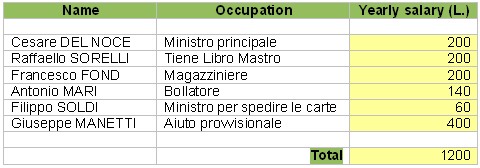
This new situation continues unaltered at least up to April 1884. For the following times, the documents are absent or unclear.
3.4 Spese Generali
As it was easy to expect, the section of various expenses is different from the other ones: we usually find the same kinds of expenses, but they are obviously never exactly the same. One contribution that is officially suppressed later on is that of “Mance per le solennità”. Actually, in one case at least, we find what practically appears as a gratuity of the same kind, to Auditore fiscale for Berlingaccio, under the changed name of Emolumenti.
Particularly interesting may be the long lists of payments of customs duties for shipping the cards to various destinations. This is however variously completed for different years, and in the course of the same year as well. Sometimes we find indicated the number of packs, sometimes it is not indicated. Only seldom we see an indication of the various kind of cards present in the shipment – in any case with Basse still representing the majority of them all.
On the other hand, all the expenses for card shipping are duly recorded. This usually occurs with three entries in each case: customs duty, cost of the box or case, carriage. To increasing numbers of packs for a given shipment, reasonably correspond bigger and stronger envelopes or containers.
The number of packs shipped vary within wide limits; it is easy to understand that there is an approximate proportionality between local population and number of packs. Thus, a few hundred packs are usually dispatched to Livorno, Siena, Pistoia, Pisa, and Arezzo, whereas only a few dozens or less are sent to minor country towns.
For purchases of paper and stationery for the Ufficio we find Gaetano Cambiagi as the usual supplier. He was the official printer of the Grand Duchy, whom we also meet in 1783 as maker of a limited amount of playing cards.
4. The production of playing cards in the years 1775-1787
This is the most interesting part for us. The number that we find of card packs produced for the various kinds is very indicative and can easily be understood without further comments. I will thus essentially report in table form the corresponding data below. These numbers could be taken directly from the initial pages of the corresponding sections in Filza 19 only up to 1780; for later years I had to sum up the individual contributions.
4.1 Yearly production of card packs
|

* Indicated everywhere as: Cartine da picchetto nostrali.
** Indicated usually as: Cartine alla francese complete.
|
|

* Actually indicated everywhere as Emanuel Sacerdote Ebreo
|
|

|
|

|
|

|
|

|
|

* The production of Zanobi Rossi and Lorenzo Tanini comes from the same factory.
|
|

|
|

As indicated in the individual pages of the receipts, I have added to the 1783 year the first purchases of 1784, as used for all previous years.
|
|

The lower number of playing cards for this year is because the purchases of the first months of the year, both for 1784 and 1785, are missing here.
|
|

* 372 Francesi with stamp duty at s.13.4 + 360 Complete at s. 15.4.
** Cucu cards with duty of L.1.3.4.
*** The spelling of this surname shows several versions in the records, from Gioia to Zoja. To be exact, this maker himself clearly writes Zoija in his signature.
|
|

* 336 Piccole + 336 Quadriglio + 144 Complete.
** 12 Cucu packs.
|
|

* The total number of packs for this year is much less than expected, but all records of this year are in a worse state of conservation and ordering. Apparently, several pages of records are missing here: four of the eight receipts kept are all dated 28 December.
|
4.2 Kinds of playing cards
I am sorry not to be able to take full profit from the information provided on the kinds of playing cards used at the time. What is recorded here is the unit cost for each kind of cards; this important information may be misleading sometimes, because the same duty could correspond to different cards, whereas in some cases apparently the same cards had somewhat different cost.
Piccole and Francesi were priced below 1L, whereas Minchiate and Basse cost more than that. In particular, I summarise in the table below the common prices for one pack of each kind of cards indicated.
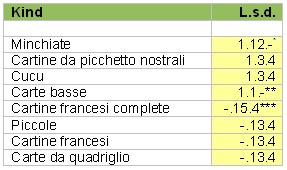
* Initially also sometimes 1.12.2 and 1.12.4; down to 1.11.8 in intermediate cases.
** Initially 1.1.4; down to 1.-.10 in intermediate cases. Sometimes we find the curious price for a pack of L.1s.-d.6+2/3 (which clearly only fits with packs traded by the dozen).
*** Initially a surprisingly low L.-s.6d.8; in intermediate cases -.15.-.
The particular kind I am mostly interested in is Minchiate, and in this case the situation is clear enough. They represented however a minor fraction of the total production, and some cardmakers did not even produce them any longer. It is plausible that they still were of the traditional pattern and shape, and that only small differences could be present between the products of different makers.
Carte Basse was the most fashionable pack. It could be considered as the current pack of the time. The common cost for them was L.1 s.1, thus intermediate between those of Minchiate and Piccole.
Carte da picchetto were mostly indicated as “nostrali”, local. Even if they were used for playing a game of the piquet family, they were easily distinguishable from the corresponding French cards.
The greatest uncertainty is in the group of Piccole. Evidently, there were various kinds belonging to this family. Cards mentioned as Francesi were Piccole, but it is not certain that the two names were perfect synonyms; they could be made as a full pack (likely 52 cards) or a reduced one.
As a reduced pack we are accustomed to deal with the 40-card pack; being however these cards of the French variety, the reduced pack was possibly that with 32 or 36 cards, with the 10s, 9s and 8s and without the minor pip cards.The production of Francesi did not follow a regular trend, showing unexpected increases or decreases; at least a part of their fortune can be explained with their lower costs.
I have confidence in the fact that collectors familiar with the Florentine cards will understand at once which precisely are the various kinds of the cards recorded in Filza 19 and profit from this quantitative information about their production.
4.3 Various cardmakers
At first sight, the observation is that at the time more makers became active in Florence than the three usual ones. However, in several cases we assist to a new maker appearing in the place of a previous one, apparently taking over the same job. This is certainly the case for Lorenzo Tanini, who worked with Zanobi Rossi earlier on. Similarly, Salvatore Tognacci is only found in the first year of the records, 1775, and Emanuel Sacerdote takes then his place.
Sometimes the cardmakers sign in person the receipts; sometimes this is done by their representatives or assistants, so that we obtain a few further names of people working in our sector, such as Jacob for his brother Emanuel Sacerdote, or Antonio Ricci, then Domenico Bianchi and Giovanni Pieroni for Pietro Molinelli.
It is evident that the production was not equally distributed among the various makers. One or two of them actually produced the main part of the playing cards recorded. Also the ratios between specific kinds of cards and the whole production was remarkably different for different makers.
5. PARTICULAR CASES
In addition to the orderly series of records described, there are in Filza 19 few scattered and unusual documents. Clearly, even an individual receipt may provide new information on a particular case, or an unknown habit.
For example, in the end of yearly sections we find attached cards with the yearly balance of the branch offices of Siena, Pistoia, Livorno, and Pisa. The quantity of cards involved is not evident, but one can derive an idea of the relative contributions of the various places. (For instance we find in 1776: L.815.16.6 for Pistoia, 2645.11.- for Livorno, and 4712.1.8 for Pisa.)
I will however focus my attention on two minor entries below.
5.1 Distribution in and around Siena
In Siena a branch office was active. In the Florentine records, we do not thus find detailed information about the local situation of Siena territory. As a useful exception let me reproduce here part of a large table inserted for the cards sold there in 1783.
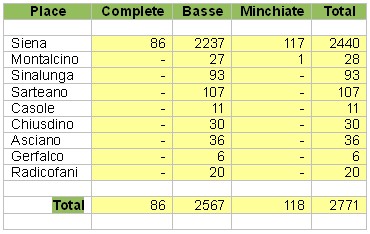
The predominance of Siena in comparison with the minor towns of its territory does not require any additional comment. This observation is valid in general, because no less than 88% of the total amount concerned the chief town.
Maybe even more interesting is however the distribution out of town of Complete and Minchiate: just one pack of Minchiate to Montalcino (now better known for its costly Brunello wine), and no pack at all of Complete - supposedly the 52-card pack.
5.2 Miniatures
One receipt in particular may be of interest in providing some unusual information: on 22 June 1785 we find a receipt to Raffaello Sorelli, whom we had found as the employee with the task to keep updated the main ledger of the office.
Here, this book-keeper unexpectedly became a craftsman, who reminds us of the painters of Naibi, active four centuries before. The office charged him to paint thirty test packs of cards and he received L. 20 for this job. The saying used is particularly interesting: he writes that he had “miniato” the cards and demands L.- s.13 d.4 for, in particular, “spese per colorire tutte le figure” of each pack. Now, we know that Miniature were fashionable many centuries before, but evidently the verb had remained in common use for similar works.
Obviously, this painter does not work on the blank face of the card, but on a card already provided with a printed image: he only paints the empty spaces there – as could also be done, in principle, in the early days of card production.
Conclusions
A thick folder coming from “Ufficio del bollo e marchio di Firenze” contains useful records on the production of playing cards in Florence in the years 1775-1787. The corresponding information has been reported and discussed.
In particular, tables with the yearly production have been provided; they represent the most relevant part of the information. As an order of magnitude, ten thousand packs of playing cards were produced yearly in Florence (to be used in the whole Grand Duchy of Tuscany) with about one tenth of them still belonging to the traditional Minchiate kind.
Moreover, several details have been reported on the functioning of the office and on individual cases recorded in the documents examined.
Footnotes:
(1) archiviodistato.firenze.it
(2) Franco Pratesi: 1791 – PRODUCTION AND SALE OF PLAYING CARDS IN TUSCANY, (2012)
(3) Franco Pratesi: 1801-07 – CARD PRODUCTION IN THE ETRURIA KINGDOM, (2013)
(4) The Playing-Card, Vol. XIX No. 2 (1990) 68-76; Franco Pratesi: CARDS AND MEN FOR cucù, 1990
|
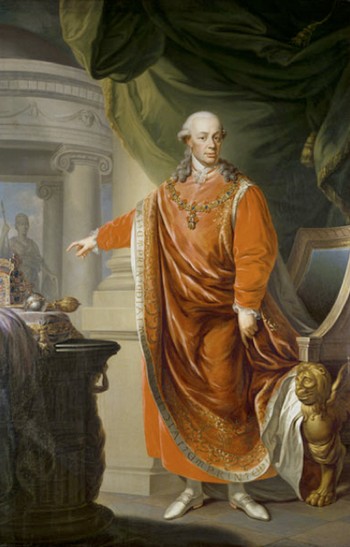
Emperor Leopold II
in the regalia of the Order of the Golden Fleece
(posthumous picture of the 1806, the year, in which the Habsburg Empire was finished)
Leopold II, Austrian Emperor in the years 1790-92, had been before Grand Duke of Tuscany (1765-90) and he was the ruling regent in the considered period of this article.
The last Medici regent, a person connected to a bad reputation, had died 1737 and Tuscany became part of Austria. The period till 1765 is considered as of a bad Austrian rulership, however, under Leopold the situation improved and Leopold is honored in the historical evaluation as "a moderate proponent of enlightened absolutism". A good regent, and Tuscany is said to have become a modern state in his time. Tuscany had been then the first state, which stopped the death penalty - there are many states, which haven't stopped this till 2013.
It's a good question, if the high Tarock playing fever, which according research broke out in Germany and Austria around 1750 and then very quickly distributed to high dimensions with very much creativity and different kind of decks had some relationship to the condition, that Austria got possessions in Italy. There was:
1700: The death of the Spanish King as the last of the Habsburger in Spain caused problems about the succession. The result was a war (1701-1714). King of Spain became Philip V., a grandson of the still reigning Louis XIV of France, but some Spanish possessions outside the Iberian peninsula dropped under control of Austria and others, mainly Savoy.
Austria got in the course of time :
1708 - 1866 with interruptions (by France): Dukedom of Mantova, lost to the new Italian state
1714 - 1797: Dukedom of Milan, 1797 lost to France
1714 - 1797: Spanish Netherlands, 1797 lost to France
1714 - 1735: Kingdom of Naples, lost to Spain in 1735
1714 - 1720: Kingdom of Sardinia, exchanged with Savoy for Sicily cause a Spanish attack against Sicily in 1718
1720 - 1735: Kingdom of Sicily in exchange for Sardinia, lost to Spain in 1735
1735 - 1748: dukedom of Parma, given by Spain as compensation for Austrian losses (Sicily, Naples) in 1735, in 1748 with the peace of Aachen given back to Spain
1737 - 1859 with interruption (by France): Grand duchy of Tuscany, somehow gotten in exchange for Lorraine, which was taken by France and an abdicated Polish king. In 1859 lost to the new Italian state.
1754 - 1859 with interruptions (by France): Austrian influence on Modena / Reggio / Massa / Carrara by engagement (1754) and marriage (1771). Lost to the new Italian state in 1859.
A map of Tuscany
The first literary document ...
... in German language for the use of "Tarock"
... as far we could find it
Tarock note 1750/51
Anakreontische Versuche, Volume 1
Author: Johann Franz von Palthen (printed by Weitbrecht)
Source: Google books, at page 35; the given text is from 1751, but according other researches (worldcat) an earlier edition existed already 1750 (though we didn't see this text). The author seems to have been an "Advocatfiscal" in Wismar, far in the North of Germany, and Wismar belonged to Sweden then.
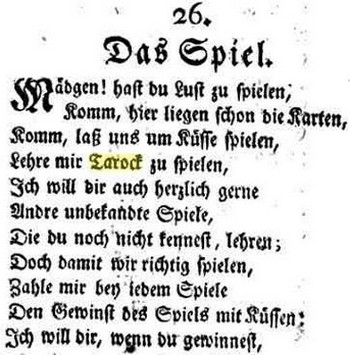
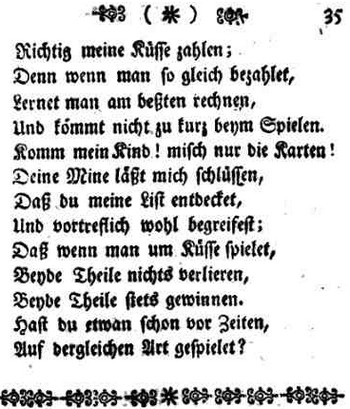
That's a love poem, and the author suggests to an admired young girl to play Tarock for kisses instead of money, cause in this case both would win, whatever the cards would say.
Tarock note 1751
"Auszug der neuesten Weltgeschichte : auf das Jahr ... ;" 1751
Author: Groß, Johann Gottfried (Erlangen ; Nürnberg 1751)
Source: Bavarica
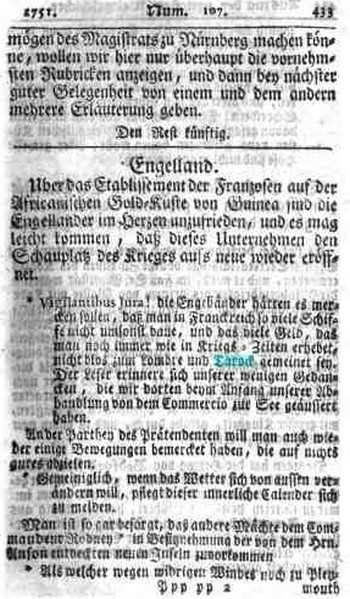
The author makes a funny remark, that the English people should have noted, that the French used their money not only to play Lombre and Tarock, but also built ships with it. The French engaged with them at the African gold coast of Guinea, and the author fears, that this operation might trigger easily a new war; after a recent great war (Austrian Succession War 1740-48) had been closed with the peace of Aachen.
Research context for both documents
2012-06-11 Tarothistory-Forum
Larger Research context
Tarothistory Forum: article "collection Germany/Austria/Switzerland"
... that'a big list with findings of literary Tarock passages in Germany / Austria during 18th century, recommended for your deeper studies, but likely only enjoyable, when you can read German language.
Thierry Depaulis in his article "When (and how) did Tarot reach Germany?" (IPCS 39/2, p. 64-79) in 2010 had as first German date 1752 (according a research from Sigmar Radau in 1989: "Tiertarock: Entstehung und Verbreitung der Tarocke in französischen Farben") and he notes: "From 1752 on there is a wealth of German sources". Which is, according our own researches, definitely true.
Sigmar Radau came according Depaulis to the conclusion, that an existing deck from Sebastian Ioia ("In Verlag bey Sebastian Joja in Augspurg" at 2 of Cups and 2 of Coins) might be dated to 1720-25 (according S.Radau & G. Matthes: Deutsche Spielkarte 1650-1900, Nürnberg, GNM, 2001, n° 18). Another deck from Jean Wolfgang Weber in Ulm is dated by Radau to c. 1735 ("TAROS FIN DE IEAN WOLFGANG WEBER A ULME"), which Depaulis considers insecure, as Weber had been active from c. 1735 till 1787. Tarot packs of Johannes Pelagius (Constance) are globally dated "mid of 18th century". A. B. Göbl, known for many Tarock decks, started his business in 1748. Definitely from 1750 is a deck "FEINE TAROS BEY FERDINAND SCHOBER IN NEUHAUS 1750" with NEUHAUS identified by Depaulis as Jindrichuv Hradek in Bohemia (part of Austria in 1750), and with 150 km to Prague and 180 km to Vienna in the middle between the both cities.
|
|






















